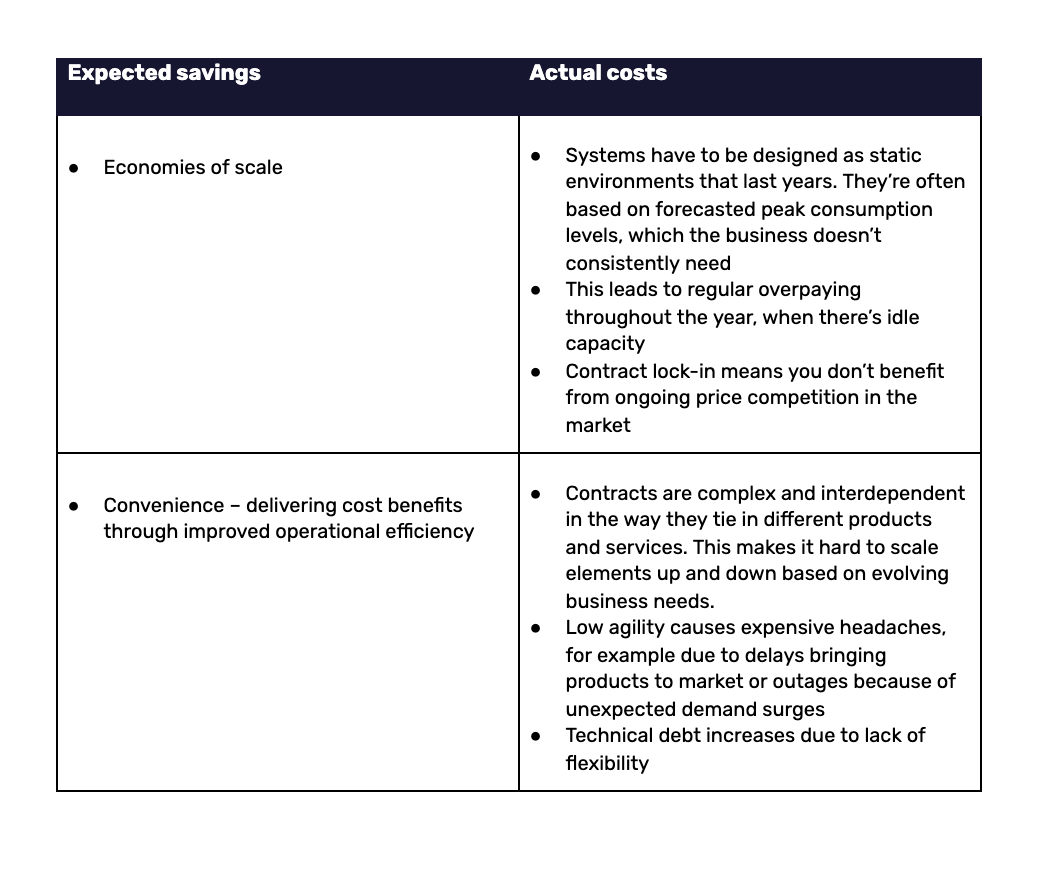
The Business Case for Multisourcing
The top IT leader challenge is managing with budget constraints, according to a latest Gartner survey. While dealing with that challenge, they also have to help build the business strategy (53%) and drive innovation (40%).
Outsourcing has been the obvious way to square this circle – offloading low-value tasks so the business can focus on high-value opportunities. But traditional outsourcing models haven’t been meeting business needs. One study found that 60% of IT outsourcing projects fail to meet their pre-defined targets. That’s why multisourcing is increasingly popular. Instead of outsourcing to a single service provider, companies are using best-in-breed vendors for different elements of their IT landscape.
Here’s why IT multisourcing is the future – both for cost savings and value delivery.
Single provider outsourcing models are no longer cost-effective
The business case for outsourcing to a single provider was based on economies of scale and convenience (which delivers cost benefits through improved operational efficiency).
The reality, however, is that the single provider model hasn’t lived up to the savings expectations – and, in many cases, has created unnecessary cost.

Inflexible consumption models, contract lock-in, low agility and increased technical debt all lead to real costs within the business – which easily outweigh the savings from economies of scale and convenience.
Businesses need more agility and flexibility to meet market needs
With rapid changes to the technology landscape and customer expectations, IT has become intrinsic to value delivery. But it only delivers that value when you can flex consumption and services based on market needs. Traditional single provider processes aren’t designed to deliver this flexibility.
When you multisource, you get a team of best-in-breed providers who use their domain expertise and tooling to fine-tune each service area. You can tweak your team at any time as required, ensuring your IT backbone is always working agilely to maximise your competitive advantage.
You then reap the following business benefits:
- You’re on the front foot because IT auto-scales – you can bolt capacity/capabilities in and out as required, so your organisation is on the front foot (whether you’re launching new products/services or reacting to factors outside your control)
- You only pay for what you use – you don’t need to lock in your system design or service requirements upfront. Instead, you pay based on your footprint on a monthly basis
- You can react quickly to capitalise on opportunities – because you’re not tied into rigid SLAs and don’t have to waste time renegotiating changes
A leading cloud specialist I know summed it up nicely:
“What the business wanted was to say, ‘I need a new VM tomorrow.’ But because of how the multi-layer contract was set up, it would routinely take 3 weeks to get it online. This was because SLAs were based on static metrics like number of VMs. We therefore had to renegotiate the support side each time we needed more capacity. We then had a time-consuming discussion of which VMs would get the support coverage, which required impact assessments and risk analysis. This drastically reduced efficiency and evolution velocity, which had real and opportunity costs.”
Sourcing models need to deliver short-term savings and long-term value
Yes, it’s conceptually easier to offload everything on to a single provider, And yes, having an ecosystem of best-in-breed providers takes time to set up initially. But, when set up in the right way, multisourcing helps you maximise both short-term savings and long-term value. The best way to save money on an IT support arrangement is to introduce healthy co-opetition between a partner network rather than locking yourself into a multi-year, multi-layer contract with a monopoly provider. That way:
- Partners are continually incentivised to keep costs down – so you maximise ROI and minimise TCO
- Your cost model is based on actual consumption at any given point – so you’re never paying for unused capacity in preparation for a future peak
- You can easily extricate yourself if requirements change – without managing layers of unaligned disconnect clauses and minimum payment notice periods
The agility and expertise you get from working with domain specialists also helps you maximise value ongoing:
- You’re hiring the right people into your IT team instead of hiring someone else’s IT department to work for your business – which means you’re building exactly the right team for delivering value in your context
- Your staff have more time to focus on areas that drive value to the business – because you have experts managing each stream and time isn’t wasted negotiating complex changes
- The business can leverage opportunities more easily and quickly – because experts help you drive innovation and optimise/scale each element of your tech stack
The right multisourcing operating model delivers greater, more sustainable value
The key to success with multisourcing is to establish the right operating model, not just for now, but for your desired state.
With the right governance, tools and methodologies, your ecosystem operates as a slick, API-driven machine. You have partners, not vendors – who are aligned to a common purpose. You essentially have a bespoke, expert IT team adhering to the same standards, supporting each other and solving issues collaboratively. What does this best-practice operating model look like – and how do you implement it so you maximise the benefits of multisourcing?
In order to define this Nordcloud can help you through its advisory practice. How can this work for your business?
Get in Touch.
Let’s discuss how we can help with your cloud journey. Our experts are standing by to talk about your migration, modernisation, development and skills challenges.

